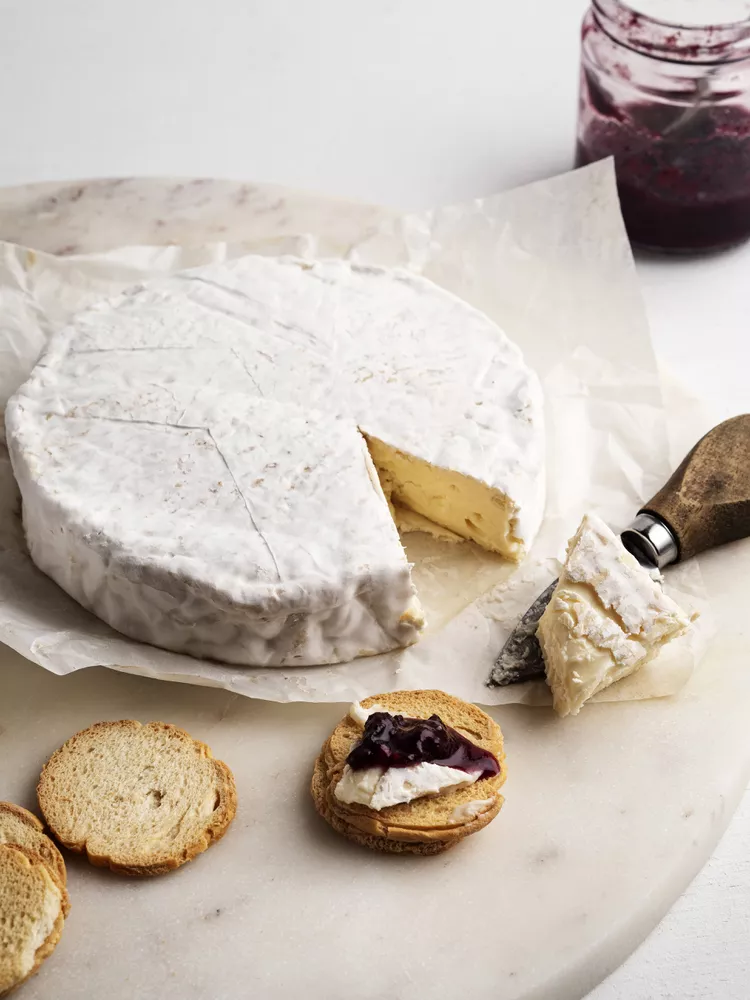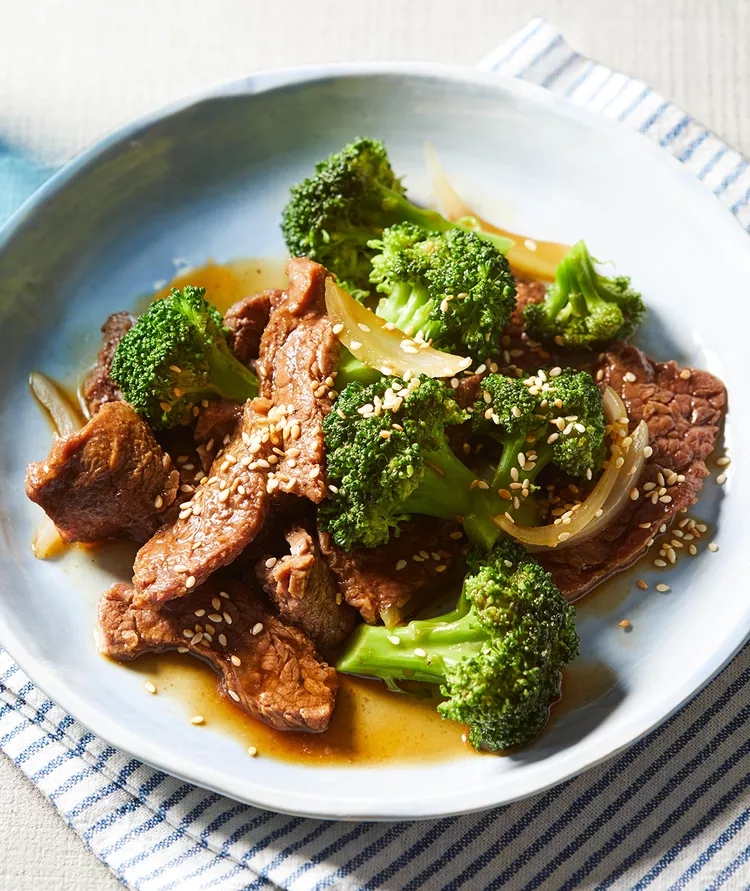Creamy burrata and versatile cottage cheese seem to be generating the most buzz in the dairy section these days, and we’ll never forget the moment that feta had (and the subsequent shortages) as a result of the 2021 zeitgeist that was baked feta pasta.
Food trends come and go, and the “cool” cheese seems to shift quicker than movies debut and are done at theaters. But there’s one steady contender for the best type of cheese for snacking, baking, and even “cake-ing:” Brie. Read on to discover more about how Brie is made and to snag tips from certified cheese pros about how to eat Brie cheese (including whether you should ditch or devour the rind).
- Brent Fuscaldo, a Chicago-based assistant team leader and certified cheese professional for Whole Foods Market
- Jessica Sennett, the Brooklyn, New York-based founder of Cheese Grotto
What Is Brie Cheese?
Besides our favorite centerpiece for a charcuterie board, Brie is a soft cheese with a bloomy, textured rind on the outside and high butterfat (60% to 75%) on the inside. According to Brent Fuscaldo, a Chicago-based assistant team leader and certified cheese professional for Whole Foods Market, it’s named after the Brie region in Northern France, where it has been served for at least 1,200 years.
Brie is now made (and savored) all over the world. The process for how to make Brie cheese has evolved over time to help deliver more consistent results in terms of texture and flavor. Jessica Sennett, the Brooklyn, New York-based founder of Cheese Grotto walks us through how it’s done these days:
- Cheesemakers heat milk and cream, then add cultures to help generate the flavor and consistency.
- After curds form, this mixture is drained and transferred to a mold to create the round shape.
- The cheese is aged and flipped every day for 2 to 4 weeks to allow it to develop a rind. As this process takes place, the Brie drains slowly and shrinks in height.
- As Brie ripens, it forms a “bloomy rind,” which refers to the naturally-occurring mold layer that blooms on the outside of the cheese. This breaks down the proteins inside (the part of the cheese that experts refer to as the “paste”) to soften the interior into the creamy consistency that’s a signature of Brie.
The paste starts off springy, and as it ages, the enzymes will continue to break it down from the outside in until it’s completely spreadable. The flavor strengthens as it ages on the store shelf or in your refrigerator, too.
“Brie cheese has different flavor profiles and textures depending on the age of the cheese,” Sennett says.
These same features also vary based on how much cream is used in the recipe, which is what distinguishes double-cream from triple-cream Brie. You might also spot herb Brie or Brie made with other types of milk, such as goat milk.
French Brie cheeses (including two prominent styles Brie de Meaux and Brie de Melun) are traditionally made with raw cow’s milk. American Brie is often made with pasteurized milk. This means that French Brie typically tastes earthy and grassy compared to American Brie’s milder flavor.
Brie cheese starts off tasting like milk and a subtle hint of mushrooms, Fuscaldo says. As Brie “ripens,” it becomes more buttery, vegetal, earthy, and umami in flavor.
5 Tips For How to Eat Brie Cheese, According to Cheese Professionals
Now that you know what Brie is and how it comes into existence, let’s dig into the fun part: how to eat Brie cheese. That might sound like a silly thing to need to explain, but we’ve had enough readers write in asking us about the cheese rind alone that we think these pointers might come in handy!
Serve it at Room Temperature (or Warm)
Your refrigerator’s crisper drawer is the best place to store Brie. When it comes time to serve, it’s wise to take the chill off.
“Brie is best served at room temperature so that the constrictive qualities of the cold fridge do not mute its true expression,” Sennett says.
Remove the portion of the Brie you plan to eat from the refrigerator about 1 hour before you plan to enjoy it. Keep in mind that Brie is also a terrific candidate for baking and serving warm (read on for more about this shortly).
Go Ahead: Eat the Rind
“The rind is a crucial component to the cheese’s development and is very okay to eat! Brie is a ‘bloomy rind’ cheese, which basically means it’s a ‘live rind,’ and is responsible for the creamy paste inside. One can’t exist without the other,” Fuscaldo tells BHG.
Fuscaldo compares the rind to the crust on bread: “It adds some depth to the taste.”
Of course, it all boils down to personal preference. Sennett suggests sampling a bite with the rind and the paste. If you’re not a huge fan of the rind’s flavor, a drizzle of honey or fig jam can often balance things out, she adds. But there’s no need to force it if you’re turned off by the flavor (which can become more intense as Brie ages) or the texture; feel free to slice it off if desired.
“The paste within is still often incredible in texture and flavor,” Sennett says.
Slice it Thoughtfully
Your best slicing strategy will vary based on the age of your Brie and the shape it’s sold in.
Brie cheese is traditionally made in wheels; larger ones are trimmed into long wedges, then wrapped and sold at stores, while smaller rounds are sold whole. The goal is to balance the paste-to-rind ratio, so Sennett recommends the following slicing techniques:
- If you’re starting with a long wedge of Brie: Slice it horizontally from the pointy side in about ½- to 1-inch slices. As you get closer to the round end, make the slices a bit thicker so the rind doesn't overpower the paste. If it’s very ripe and already in a wedge shape, don’t slice the Brie in advance, Sennet says, as “it will become very spreadable and runny when served at room temperature and won't hold up to pre-cut portions.”
- If you’re starting with a small round of Brie: Use a knife to cut smaller wedge slices. “This offers equal parts of the rind for each piece,” Fuscaldo explains. “Like a nicely wrapped present!”
Pair Brie Wisely
It’s tough to beat a schmear of buttery Brie on a piece of warm baguette, Fuscaldo and Sennett agree. It plays nicely with honey and fruit spreads, too so feel free to layer one of those on, too.
Young brie is brilliant baked. Warm a wheel and top it with roasted garlic or fig-and-pistachio tapenade, or wrap Brie in puff pastry and bake it for a classic Brie en croute.
If you’re assembling a cheese tray or a charcuterie board, Brie pairs nicely with salami, prosciutto, or any other cured meats, nuts like almonds and walnuts, as well as stone fruits such as peaches, nectarines, and apricots.
As for leftovers, if you’re lucky enough to have them, incorporate them into Zucchini-Brie Breakfast Casseroles for brunch, a grown-up grilled cheese sandwich for lunch, or Macaroni with Brie and Crab for a decadent day-two dinner.
The best drink pairings for Brie include dry sparkling wine (“It lifts the rich texture of the cheese off the palate and will balance the more intense flavors of a ripe Brie,” Sennett says), Chenin Blanc, Chardonnay, Gamay, Pinot Noir, and Cider.
Enjoy it in Due Time
Refer to the “best by” date on your Brie or ask your cheesemonger about when you should try to consume your Brie cheese by. When in doubt, refrigerate your Brie and aim to enjoy it within 3 weeks when stored in its original packaging, or within 7 days after opening.
Signs of spoilage include sliminess, grittiness, a sour or rancid smell, orange spots, and fluffy or blue mold growth.




















